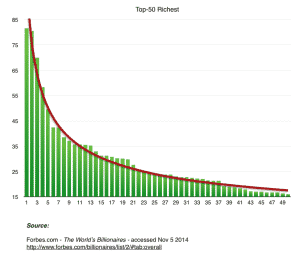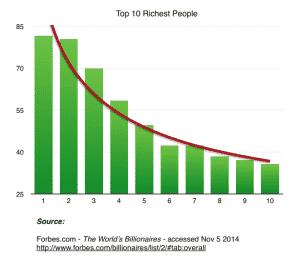In today’s “always-on” world, the 80/20 Rule is more important than ever.
We face greater complexity, speed, and connectivity than any generation of entrepreneurs before us.
Cutting past the 80% noise to find and focus on the vital 20% that really matters is the only way we’ll maintain sanity.
What was once a casual analysis tool, the 80/20 Rule is now a daily discipline necessary for success and survival.
Time-Tested, Billlion-Dollar Strategy
The 80/20 Rule (a.k.a. Pareto Principle), was discovered over 100 years ago when Italian economist Vilfredo Pareto noticed how 80% of his country’s land was owned by just 20% of citizens, and – curiously – 80% of his garden peas came from just 20% of peapods.
Again and again he noticed life, business, and nature was divided squarely between “Vital Few” and “Trivial Many.”
Since then, all of the world’s most successful and iconic entrepreneurs and investors have used versions of the 80/20 Rule to amass incredible fame and fortune.
Amongst them, Richard Koch (pictured above, beside me) and Warren Buffett.
In The Tao of Warren Buffett, authors Buffett and Clark report that 90% of Warren’s $60 Billion empire is thanks to just ten investments. Not hundreds of investments – just ten.
They further explain how Warren deeply values what a firm doesn’t do just as much as what it does. What is the 80% (or more) the firm will leave alone?
In his 1990 letter to Berkshire investors, Buffett proclaimed, “Lethargy bordering on sloth remains the cornerstone of our investment style.” Billionaires GET IT.
And yet entrepreneurs continue to shrug casually, indifferently at at the 80/20 Rule, never really taking it seriously, opting instead to scratch away furiously at their To-Do list, 80-hour week after 80-hour week.
Baffling.
Below you’ll learn what the 80/20 Rule is, how to take advantage it, and what brutal consequences you may face if you ignore it.
Thank-you Perry Marshall and Richard Koch for inspiring me to study and integrate 80/20 into all areas of my life, both business and personal.
Life is NOT “Fair”
Growing up we learned (erroneously) life is 50-50, where everything is equally important.
In school, a strong report card meant doing well across all subjects, all classes contributing evenly to our average.
Socially, everyone was supposed to give and receive equal treatment. If you gave a Valentine’s Day card to one person in class, you’d better give one to everyone.
At family reunions you’d better hug everyone, including loud, obnoxious Uncle Norm who embarrassed you in front of everyone and stunk horribly of cigarettes.
Despite their best intentions, our teachers at home and school were inaccurate about 50-50. There’s actually very little 50-50 in life.
In reality, it’s all about 80-20 where 20% of inputs generate 80% of results.
Remember the one bully in class created 80% of havoc.
The one or two girls got 80% of boys’ attention.
And – fondly – one or two “best friends” who were repeatedly by our side as we created 80% of our most-cherished childhood memories.
The difference between school’s “50-50” approach (a bell curve) and the real-world’s “80-20” reality (a skew curve) looks like this:
Examples of 80/20
80/20 is literally everywhere in modern-day life. Consider:
Forbes 500 Richest-People List
In 2014, I took the list of the Forbes 500.
I knew there’d be numerous 80/20s stacked on top of each other, so I only plotted the Top-50 richest people. Here’s the graph:
Looks suspiciously like an 80/20 Skew curve, wouldn’t you say?
I did the math, and 80% of all wealth on the Top-50 list is retained by only 34 people. Technically it’s “only” an 80/68, but still acres away from 50/50.
Drilling further into the Top-10 wealthiest, we see the skew curve again:
It doesn’t matter how much we zoom in or zoom out, the skew curve shows up again and again. Whether it’s just the Top-10 richest people in America, or the entire United States’ population of 300 Million people, 80/20 is alive and well.
Your Online Spending
This is an educated guess, but you probably spend 95% of your online dollars on 10 or fewer websites (Amazon, eBay, Zappos, Victoria’s Secret… sounding familiar?).
Considering there’s now approximately one billion (with a B) websites online, those 10 websites represent a 95/0.000000005, which is far, far, far more extreme than 80/20.
And within those 10 websites that get 95% of your online dollar, there’s probably one or two that trump all others combined, representing a second-layer of 80/20.
Amazon, anyone?
Your Contacts, Friends and Confidantes
According to Pew Research conducted in 2011, the average American has 634 people in their network, including friends, family, coworkers, and other acquaintances.
In a 2004 poll, Gallup discovered Americans (on average) have approximately nine close friends. We see 80/20 appear: of 634 contacts, only 9 (or 1.4%) are considered close friends.
A 2010 study done by Cornell University went further, revealing Americans have – on average – two really close friends, people they’d consider confidantes to share life’s most personal matters. Another 80/20 has emerged: of nine close friends, only two are close enough to be confidantes.
In summary, out of 300 Million people in the US, Americans have (on average) 634 contacts, of which nine are close friends, of which just two are true confidantes.
300,000,000 : 634 : 9 : 2
That’s three levels of 80/20 playing out perfectly, and one helluva skew curve.
And of course we could keep going:
- you probably spend 95% of your talk-time speaking with fewer than 5% of contacts in your phone
- you probably spend 95% of your Facebook chat with fewer than 5% of your “friends”
- you probably spend 80% of your time at home in fewer than 20% of square footage (bedroom likely heaviest-used space at 6-8+ hours per day for sleeping, relaxing, clothing, and organizing)
- …and on and on and on…
In business examples abound too:
- 80% of sales come from 20% of customers
- 80% of sales come from 20% of products
- 80% of hassle comes from 20% of clients and 20% of staff
Actually, It’s Harsher than 80/20
As we’ve already seen in the examples above, often business and life are harsher than 80/20. This shows up in two (related) ways.
First of all, the distribution is often more extreme than 80/20, often playing out as 90/10, 99/5, or more. (Note: the two numbers needn’t add up to 100.)
Secondly, there’s actually an 80/20 inside of each 80/20.
Let’s say you’ve got 100 books on your bookshelf. 20 of them represent your favorite. But of your favorite 20, there’s just 4 books which are your prized possessions. And perhaps 1 of those 4 is so meaningful, you’d literally take it to the grave with you.
That’s the multiple 80/20s stacked on top of each other.
In anything – people, customers, opportunities, friends, lovers – drilling down to the Top-20 is only “round one” of thinking. Push for the second round of 80/20 and you realize a full 64% of your success (or failure) can be attributed to just 4% of your efforts. Keep pushing for extra rounds until you’ve hit the end.
How to Do 80/20
It’s fascinating and fun to learn about 80/20 and consider how it shows up in life.
But the true value is when you implement.
In 80/20 there’s two crucial steps:
- 1) Slash the bottom 80%, which frees up significant new time, energy, space, and (possibly) money to re-invest elsewhere, business or personal.
- 2) Then, using some (or all) of your newly-available resource, “Double-down” on the top 20%. Ditched the bottom 20% of (nightmare) clients? Amazing – now hit the gym 4x instead of 2x. Or come home for dinner with the family at 5pm instead of 630pm. Or go to bed an hour earlier.
(Thanks to Greg McKeown for the term “double-down,” from his incredible book Essentialism.)
Perhaps dropping the bottom 80% is too extreme for you. OK.
But for heaven’s sakes, cut the bottom 20% that brings you 80% of stress!
If your finger is trembling on the trigger, not quite convinced to swing into action, read this important blog post about “Opportunity Cost“. Most humans – entrepreneurs included – ignore this concept to their great peril.
In fact, anyone who truly owns the reality of Opportunity Cost in their own life can’t help but race to implement 80/20 in their life as far, wide, and quickly as possible.
What Opportunity Cost is playing out in your life right now?
Take a Stand and Make the Leap Immediately
For goodness sakes, start right here and now.
Doesn’t have to be heroic – just start somewhere.
Give away the 10 books you know you’re never going to read.
Donate that bottom drawer of clothes you haven’t even slid open in the last 24 months.
Call the gossipy, energy-sucking friend that wants to do dinner and downgrade it to a coffee to minimize her damage on your psyche.
You already know what the Bottom-20s are – don’t kid yourself. Now do something about it! Name one activity/thing/person that you’re going to focus less time on so you can focus your time/money/energy on what really matters, leave me a comment below!
And most of all, remember you’ve got only one life to live. You’re the author of it.
Join me on the 80/20 journey.
Onwards and Upwards,
Tim :)




Great article!
Thanks James!
Thanks James Vannelli – it's such an important topic! Hope you're well :)